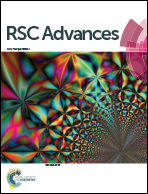BiOBr/BiOCl/carbon quantum dot microspheres with superior visible light-driven photocatalysis†
Abstract
In this paper, BiOBr/BiOCl/CQDs heterostructure microspheres were successfully synthesized via a facile solvothermal method. Then, the structures, morphologies, optical properties and photocatalytic performances were investigated. This research showed that the BiOBr/BiOCl/CQDs microspheres exhibited significantly enhanced photocatalytic performance compared with BiOBr/BiOCl. In the photocatalysis process of rhodamine B (RhB) under visible light irradiation, the highest photodegradation rate (0.0609 min−1) would be obtained when the weight percentage of CQDs was appropriate, which was about 2.8 times higher than that of BiOBr/BiOCl (0.0217 min−1). In this photocatalytic system, the enhanced photoactivity was mainly attributed to the heterojunction interface among CQDs, BiOBr and BiOCl, and enhanced light harvesting for the appropriate CQD introduction. The radical trapping experiments revealed that O2˙−, e− and h+ were the main active species during the photocatalysis process.



 Please wait while we load your content...
Please wait while we load your content...